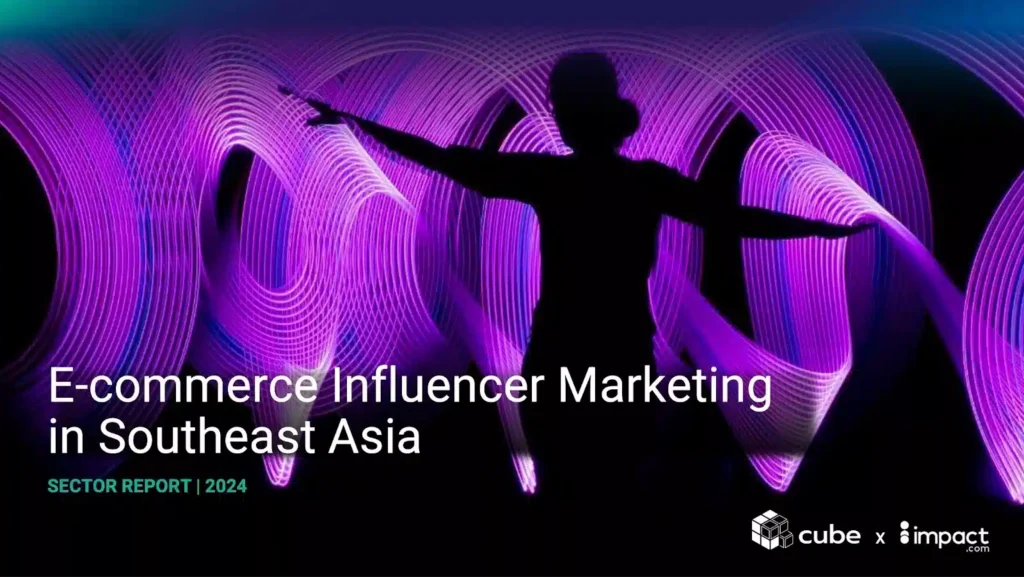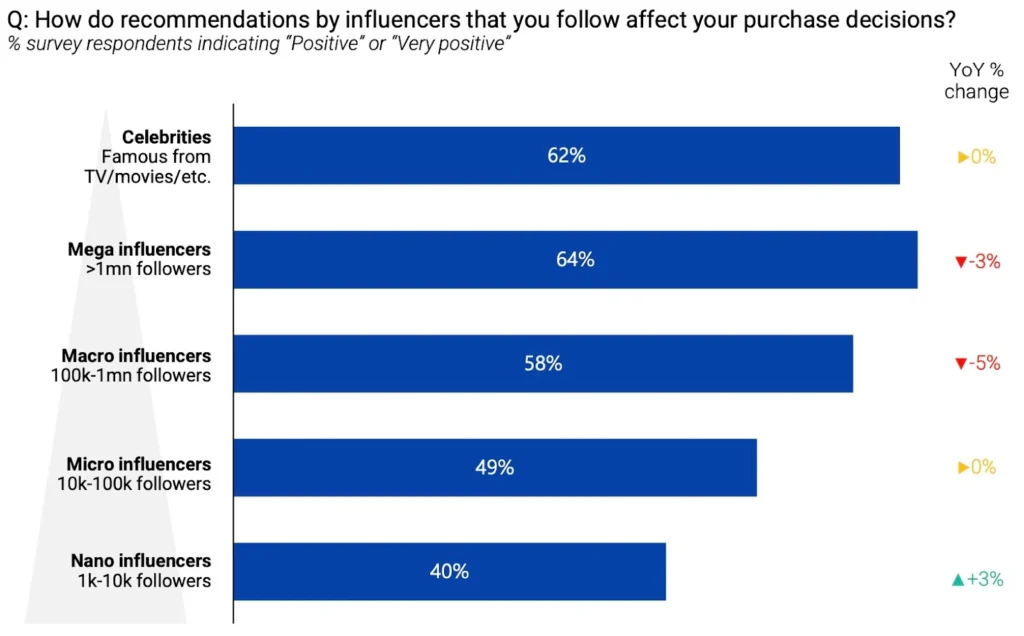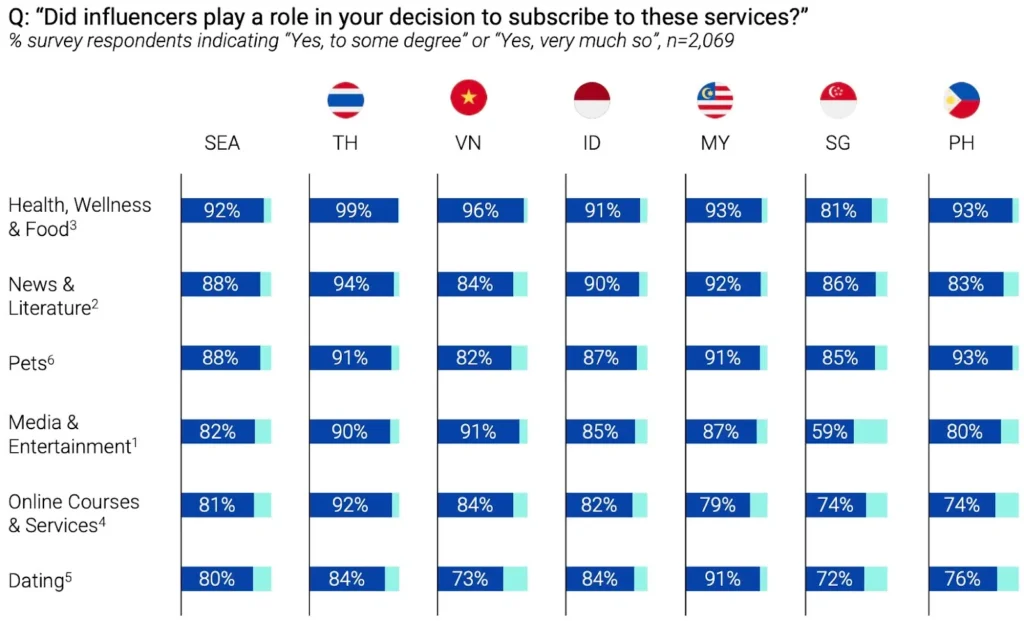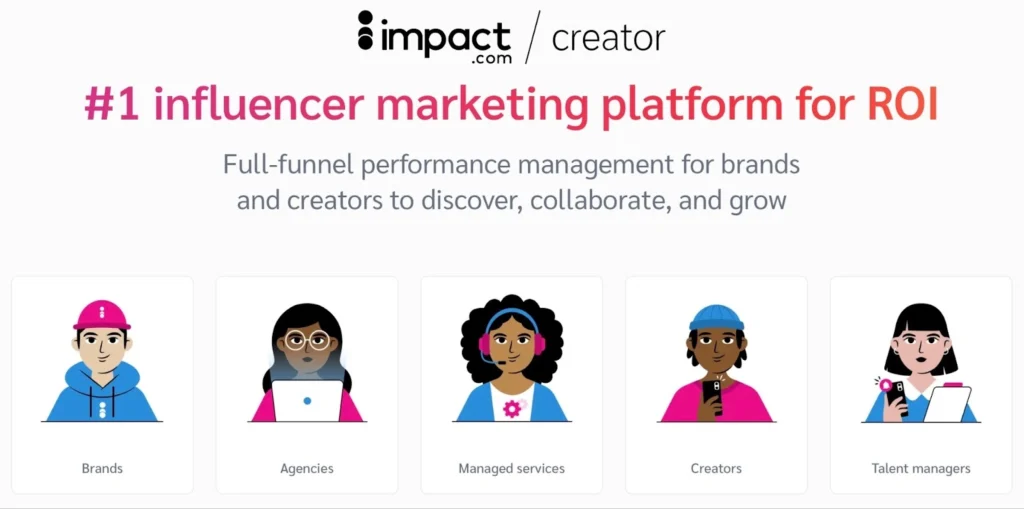Influencer marketing in Southeast Asia is transforming the region’s eCommerce landscape in 2025, now driving 20 percent of all online sales and projected to reach $125 billion by 2027.
As social commerce evolves across YouTube, Facebook, and emerging platforms, brands need data-driven insights to stay competitive. The 2024 Southeast Asia eCommerce Influencer Marketing Report, a collaboration between impact.com and Cube Asia, reveals how shopping habits are transforming—and what this means for your marketing strategy.
This analysis breaks down key findings from the report, offering actionable insights whether you’re launching your first influencer campaign or optimizing an existing program.
6 Key Southeast Asia Influencer Marketing Trends
The Southeast Asia eCommerce Influencer Marketing Reportspotlights how Asian influencers are redefining creativity, authenticity, and community across the region’s digital playground.
Key industry dynamics shaping the region include:
- Creative Freedom & Personal Style – Influencers are increasingly selective, emphasizing content that aligns with their personal values and creative vision.
- Alignment of Values – Brands and creators now prioritize shared ethics and social causes to ensure effective collaborations.
- User-Generated Content (UGC) – Authentic, relatable posts continue to outperform polished ads, strengthening engagement and conversions.
- Artificial Intelligence (AI) – Tools now assist Influencer Managers in identifying Strategic KOLs and tracking campaign ROI.
- Long-Term Partnerships – Many Senior KOLs and nano-influencers are forming deeper, ongoing brand relationships rather than one-off collaborations.
- Influencer-Led Events – Offline and hybrid activations are bridging digital and physical touchpoints, deepening audience loyalty.
The report surveyed over 2,400 participants—consumers, brands, agencies, and creators—across Singapore, Malaysia, Indonesia, Thailand, Vietnam, and the Philippines. Together, these insights reveal how creative process, trust, and technology are reshaping the future of brand–creator collaboration in Southeast Asia.

Let’s break down six of the report’s core takeaways (and how they’re affecting SEA brands currently):
1. Trust Becomes the New Currency in Influencer Marketing
Trust drives successful influencer marketing. Authentic partnerships build loyal customer bases far more effectively than chasing follower counts alone. Influencers who forge genuine connections with their audiences—through relatability and effective communication—create recommendations that truly resonate.
In Southeast Asia, audience size typically correlates with an influencer’s ability to sway opinions, but the power dynamic isn’t static. Mega-influencers (over a million followers) now leave a more favorable audience impression than traditional celebrities on social media. And nano-influencers (1,000 to 10,000 followers) are moving upward in audience trust rankings. They’ve become three percent more effective at driving purchasing decisions than last year.

Specifically, Thailand stands out as the leader in the region, with 92 percent of consumers relying on influencer recommendations. In contrast, Singapore is next at 76 percent—still a strong figure.
Brand tip:
Instead of working with the biggest names regardless of their typical content and values, find authentic content creators with strong engagement metrics and existing expertise in your industry.
These talented influencers have already built an audience potentially interested in your products. So, look for partners aligned with your brand on niche interests, style, and values—whether they’re mega-influencers or growing nano-content creators (or somewhere in between).
2. Full-funnel impact replaces single-channel approach
Many approaches to influencer marketing need to be updated. Some marketers still see influencers as a rigid part of the marketing funnel: helping raise brand awareness and nothing else. As influencer partnerships make up a bigger chunk of revenue annually in Southeast Asia, this narrow view couldn’t be further from the truth.
For brands, influencers can now play key, multifaceted roles in your customer’s buying journey:
- Mega influencers boost brands’ reach and awareness with wider audiences.
- Micro and nano influencers with niche knowledge and strong audience trust help people compare products and win shoppers.
- Partnering influencers and ambassadors share referral links and promo codes from brands—sealing the deal and converting customers into future referral partners.
Brand tip:
Think big with influencer marketing. These talented communicators, content creators, and thought leaders can be fantastic ambassadors and partners. Many influencers now play crucial roles across the entire customer journey.
3. Subscription services emerge as key influencer opportunities
As a business model, subscriptions are booming. It’s easy to see why: brands turn one-time purchases into repeat revenue and build long-term relationships with their customer base.
Trusted influencers are now a driving force behind raising awareness and sign-ups for these subscriptions. Through their posts and content, they can dive into the upsides of subscribing and encourage their followers to sign-up with a referral or discount code directly.
Across Southeast Asia, “Media & Entertainment” is the most subscribed category with 75 percent usage. However, regarding the specific impact of influencers, the “Health, Wellness, & Food” and “News & Literature” subscription categories came first.
Survey respondents in Malaysia reported the highest effect from influencers recommending subscriptions: 89 percent said influencers played a role in their purchase. By comparison, Indonesia ranked at 87 percent and Singapore at 76 percent. Even though Singapore’s metrics are the lowest for the region, they still show influencers’ massive impact on subscription sales.

Brand tip:
If you’re a subscription business, you must keep shoppers engaged and coming back, so, invest in your influencer partners. They can be strong advocates for getting their followers to take the leap and try your subscription service (especially compared to a basic ad with limited information).
4. Travel decisions shift toward influencer recommendations
Whether recommending destinations, airlines, or resorts, influencers are fantastic ambassadors and partners for travel brands. Consumers look to influencers for advice and inspiration on where to go, how to get there, and how to pass the time. Plus, gorgeous influencer posts and fun travel videos are the perfect content format for showcasing the best places to eat, stay, and explore. With the right social media partners, your brand will look better than ever.
The report shows how significantly influencers are swaying travel purchases across Southeast Asia. Currently, 78 percent of people say influencers impacted their flight bookings, and 80 percent reported making accommodation choices based on influencer content.
Brand tip:
Online searches, family and friends, and travel review sites are Southeast Asia’s top resources for travel bookings. However, the impact of influencer recommendations keeps multiplying. By teaming up with influencers, travel brands can highlight unique, culturally rich experiences and boost interest in local tourism.
5. Platform adoption accelerates influencer success
What is live commerce? It’s a fun, engaging livestream format where a host features products and hands-on demos. Live commerce has taken Southeast Asia by storm, especially in the “Fashion & Beauty” product category. The other fastest-growing live commerce categories (particularly on TikTok) are “Food & Beverages,” “Home Goods,” and “Electronics.”
Across the region, 88 percent of people reported watching live commerce within the last year (and 25 percent watch daily).
TikTok is the most popular live commerce platform, with 75 percent usage, followed by Shopee, at 61 percent, and Facebook, at 47 percent, respectively. Live commerce audiences reported being mainly motivated by:
- “Good Deals” at 71 percent.
- “Product Reviews” at 66 percent.
- “Entertainment” at 50 percent.
Brand tip:
Live commerce is the perfect content format for detailed, influencer-led product reviews. These creators can highlight your products and showcase their unique features and selling points in real time. This can significantly boost your brand’s conversion rates, as seen by 64 percent of Malaysian shoppers buying because of live commerce reviews.
6. Tools and platforms for influencer marketing success
Sustainable influencer programs require investment in influencer discovery and vetting, performance tracking, contracting, payments, and other features. Otherwise, you’ll always struggle to keep your partners informed, supported, and rewarded accurately. It’s tough to track new trends, give partners actionable feedback, and make the most of new marketing opportunities without accurate data all in one place.
Southeast Asian brands are solving these logistical challenges in different ways: from starting a system from the ground up to fully outsourcing to an agency.
Brand tip:
Using impact.com’s powerful influencer platform, your brand can focus on what really matters without reinventing the wheel yourself. With powerful automation, detailed reporting tools, customizable contracts, and more, impact.com helps you forge (and maintain) thriving influencer partnerships. With impact.com’s offices in Singapore, Malaysia, and Indonesia, the team also offers regional expertise and local support to the SEA brands.

Why Influencer Partnerships Drive growth in Southeast Asia
Influencers are now integral to how brands market products and keep customers returning. You can collaborate with these talented creators through mutually beneficial partnerships to boost your name recognition, industry authority, and consumer trust. With the right tools, you won’t have to waste time and resources chasing these trends. Instead, you can start collaborations with influencers today, which will become the core of your marketing plan.
Here’s an important takeaway on the state of influencer marketing in Southeast Asia today:
“Our latest report reveals a powerful truth: influencers are driving conversions not just in physical goods, but also in high-growth sectors like online travel and subscription services.
The recommendation power of influencers is reshaping the way brands connect with audiences across SEA. The time to act is now. Brands that fail to pivot to influencer marketing risk being left behind.”
Adam Furness, Managing Director, impact.com APJ
To dive into the details and find out more about SEA influencer marketing success, check out the full report here!
Frequently Asked Questions About Influencer Marketing in Southeast Asia
Influencer marketing in Southeast Asia blends creativity, cultural relevance, and community-driven engagement. Asian influencers build trust through storytelling, user-generated content, and authentic personal style. Brands use these creators across the entire marketing funnel—from awareness to conversion—to drive eCommerce growth, subscription sign-ups, and social commerce sales. With diverse follower bases and region-specific trends, Southeast Asian brands rely heavily on creators to spark product discovery and influence purchasing decisions.
Southeast Asia is one of the world’s most active regions for social commerce. TikTok leads due to its explosive livestream shopping ecosystem, followed by YouTube, Facebook, and Instagram. TikTok is especially dominant in live commerce, with 75% usage across the region. These platforms give Asian influencers the ability to merge entertainment, product reviews, and real-time engagement—making them essential channels for brands.
The region has a wide creator spectrum: mega-influencers for mass reach, micro- and nano-influencers for niche engagement, and Senior KOLs and Strategic KOLs who drive conversions through deep expertise and community authority. Many Southeast Asian brands increasingly prefer micro and nano creators because their authenticity and close relationships with their follower bases boost trust and purchase intent.
Cultural nuance plays a central role. Personal style, creative freedom, and respect for regional values shape how influencers communicate. Audiences value creators who address social issues, celebrate local traditions, and share relatable lifestyles. Creators such as Charissa Sevilla, Rachat Ploungphet, Doan Ngoc Mai Khanh, Adisty Primatya, and Claudia Pusung show how cultural identity drives trust, authenticity, and community engagement across the digital playground of Southeast Asia.
Southeast Asia is more community-centric and commerce-driven than Western markets. Unlike Europe or North America—where influencers often focus on awareness—Southeast Asian creators influence full-funnel outcomes, especially via social commerce. Livestream shopping, influencer-led events, and long-term partnerships are also far more common in SEA. Trust, relatability, and personal recommendations strongly shape conversions, making Asian influencers uniquely powerful.
Influencer marketing is extremely effective in SEA—now responsible for 20% of all eCommerce sales. The region’s deep trust in creators, combined with booming social commerce adoption, significantly boosts conversions. Influencer-led events, live commerce sessions, and user-generated content help shoppers move from discovery to purchase faster. This is why industries like travel, subscriptions, and beauty see massive ROI from creator partnerships.
SEA is diverse, and each market differs in culture, language, platform adoption, and consumer expectations. Marketers often struggle with:
- Managing multiple local creator ecosystems
- Incorporating creative freedom while maintaining brand control
- Identifying the right Senior KOLs and Strategic KOLs
- Navigating fragmented social commerce platforms
- Ensuring consistency across cross-border campaigns
These challenges make structured workflows and strong regional insights essential.
Most Southeast Asian countries require clear disclosures for paid partnerships and sponsored content. Regulations differ by market, but guidelines typically include transparent labeling, accurate product claims, and compliance with advertising and consumer protection laws. Brands must ensure their creator partners follow each country’s rules for public disclosures, taxation, and consumer safety.
SEA brands track ROI using metrics tied to awareness, engagement, and conversion—especially via social commerce data. Key indicators include traffic from creator links, live commerce conversion rates, subscriber sign-ups, UGC performance, and full-funnel attribution data. Because long-term partnerships are becoming the norm, brands also measure how ongoing creator relationships impact loyalty and repeat purchases. Using a platform like impact.com helps unify tracking, reporting, and payouts across markets.




